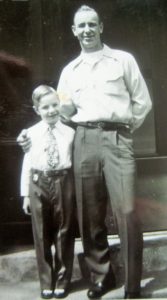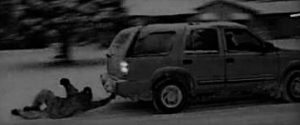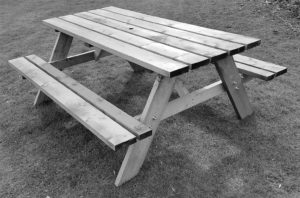One of my experiences during the Viet Nam War. Continued.
I think we fell in love. Well, I say that with reservations.
Perhaps it was just two people finding each other in a maze of
confusion, fear and uncertainty, and, in our youth, clinging to the
affection we showed each other. I wish we could have understood each
other much better, but, sometimes, just holding hands and looking
into each others’ eyes, says it all. I would look forward just to go
on a courier run and spend a little time with my makeshift family in
Bien Hoa.
She was Buddhist and I was Catholic. And, I knew that would
cause a problem with our families if we ever decided to marry! I
think what really impressed Hanh one day was that she saw a square
little bulge in my shirt pocket, and shaking her finger at me, said:
“You numba ten Ba Muoi Lam!” which means I fooled around a
lot with women. I realized she thought I had a condom in my pocket,
so I reached in and showed her it was a small religious figure in a
protective pouch (given to me by my mother). She smiled and came over
and kissed me on the cheek.
As far as I remember, she was always there in the afternoons
that I came by. And, working at the bar, she made good money to help
support her family and school expenses. She evidently came right from
school which would explain the white ao-dai and pageboy hairstyle.
Although her job was to fraternize and hustle drinks, I noticed if a
guy got too familiar with her she would leave him sitting there and
move to another. She began to sit with me whenever she could, when it
was slow, not requiring me to buy her any tea. This upset the owner,
so I started bringing him a bottle of something whenever I came which
kept him happy ( a side note is that we learned to tear the label off
the bottles so the owners could not refill them with moonshine). It
got to the point that Hanh would basically stop working when I
arrived and just sit with me. I would walk into the bar, and the
other waitresses, seeing me, would smile, welcome me, and call for
Hanh. She would come over, gently grab my hands, and we would sit
down together. Those times became so precious to me that this
beautiful girl, this Vietnamese girl, actually enjoyed being with me,
a young man brought thousands of miles to her country to fight in a
war. It started me wondering about fate, and how we become involved
in other peoples’ lives through a series of unplanned events. We
never had the opportunity to be together intimately.
As far as I remember, I was the only guy in my company who was
seeing a Vietnamese girl on a regular basis. I had mentioned it to a
few of my buddies with mixed reactions. Of course, the biggest
drawback was that even if you fell in love with a National, which the
army frowned upon, your tour of duty was one year and then you were
shipped out. It was extremely difficult to process papers that would
allow you to be married, and almost impossible to bring the girl home
with you. I decided, since I had eight months left, to begin the
procedure necessary to see if I could bring my “family”
home with me. I wrote my parents.
Needless to say, it was pathetic. My parents were against the
idea. My Captain and the chaplain tried to discourage me by telling
me that it was simply an emotional experience due to being far from
home and lonely; missing my family and friends, and, if I would
forget the idea, once I got home and resumed my normal life, I would
see how doing this would have been a mistake. I was told the girl,
and boy, would have a difficult time adjusting to American society,
that they would be subject to racism, feel disconnected from their
culture, and would, eventually, become disenchanted with their new
lifestyle. I was told to wait.
Being refused, I sought advise from my buddies. They told me
since Hanh was Buddhist, that I could arrange a “limited time”
marriage. It seems that some Vietnamese families would allow their
daughter to marry a soldier for a period of one year- His tour of
duty. This allowed the family to keep its’ status, and the girl, to
keep her “honor” intact. This was allowed (but not
recognized by the military) since most everyone knew it would be
difficult to carry on a relationship after the soldier returned home,
and even more difficult to send for the girl at a later date. Or, I
could, as one friend suggested, just enjoy the moment; don’t worry,
be happy. Well, I wasn’t very happy about my choices. I chose to wait
a month or two, and then, if my feelings for Hanh grew stonger, I
would try again more forcefully.
Our relationship grew from August through December. When I was
off duty, I would try to get as many eight hour passes I could (my
Captain was very understanding) to get into town to see her. I could
hop in a Lambretta and be there in a matter of minutes, as the town
was easily accessible from the base, and, for the most part,
considered very secure. It was that false sense of security that
would almost destroy the town during the TET offensive of 1968, and
cost the lives of many people.
I would bring gifts for Hanh and Son. Nothing much, just the
proverbial chocolate bars and perfume. She was my comfort as I was a
stranger in a strange land. We tried to teach each other our
respective languages and she fared much better than I did (I think
she was getting help from her fellow barmaids). Soon, we were able to
talk with each other a little : “I like you. You like me?”
“Anh yeu em. Co dep lam.” I still remember the phrases. I
once asked an ARVN (Army of the Republic of Vietnam)soldier how to
say “I like you very much.” in Vietnamese. He wrote it down
and I practiced it, and, when I saw her, I used it, and her puzzled
look informed me I was not using the proper inflections. I tried
again and this time her face broke out in a heart-stopping smile when
she understood: “Toi thich co nhieu lam.”
It was that time when as a young man trying to adapt to a
totally strange environment ( did you ever go shopping with an M-14
slung over your shoulder?), I met this wonderful girl, my lifeboat in
a sea of contradictions. The Army taught me how to fight and survive
but it never taught me about the people and their culture whose land
we were blowing up. I consider myself lucky because I had contact
with Vietnamese civilians, not just the enemy. I got to know these
gentle people and some of their history and culture, and that would
have a bearing on the way my life would turn out years later.
I was naive back then. I knew she was a bar girl but I also
knew some of the reasons why. In a war torn country full of lonely
foreign soldiers, it’s a good paying job for a minimum amount of
effort. I never thought about what she was doing at work when I
wasn’t there. Maybe I was just stupid or very trusting. But I do know
that when I showed up at the bar, she immediately came to me and we
stayed together until I left several hours later (provided I brought
the owner his tribute).
There was a small back room where employees could eat and take
a break. She would take me back there and we would sit alone together
and eat and drink cola… and hold hands. Sometimes, another waitress
would come back there and, seeing us, would put her hand on Hanhs’
shoulder, say something in Vietnamese, causing her to cover her face
with one hand in a modest blush. They would giggle and then the other
girl would leave.
There was one time when Hanh went out and bought us this fish
sandwich. The Vietnamese would place this fish on a platform six to
eight feet high and sun dry it. Then they would smother it in
nuoc-mam ( a fish sauce) and place it in french bread. Well, I wasn’t
used to this, and I took a bite and pretended to chew and when she
wasn’t looking I would take it out of my mouth and place it in my
pocket. Several times I left the bar with pockets full of partially
masticated meat, tossing it out before I reached camp. How I would
like, once more, to sit with her like that and this time I would
actually eat the sandwich.
One day when I visited Hanh, she gave me a photograph of herself in an outfit that, for her, was unusual. She was wearing a cowboy type shirt and hat, wearing sunglasses; strumming a guitar. She pointed to the photo and said: “You give one for me.” I promised I would, And then, with a lot of pointing and hand gesturing, I explained I would like a photo of her in the ao-dai, the way she usually dressed. She understood, and the next visit, she gave me the photo I wanted and, on the back, had written something in Vietnamese. At the time, I didn’t have it translated, and, after she died, it would not be translated until 1989…21 years later.
end of part 3


